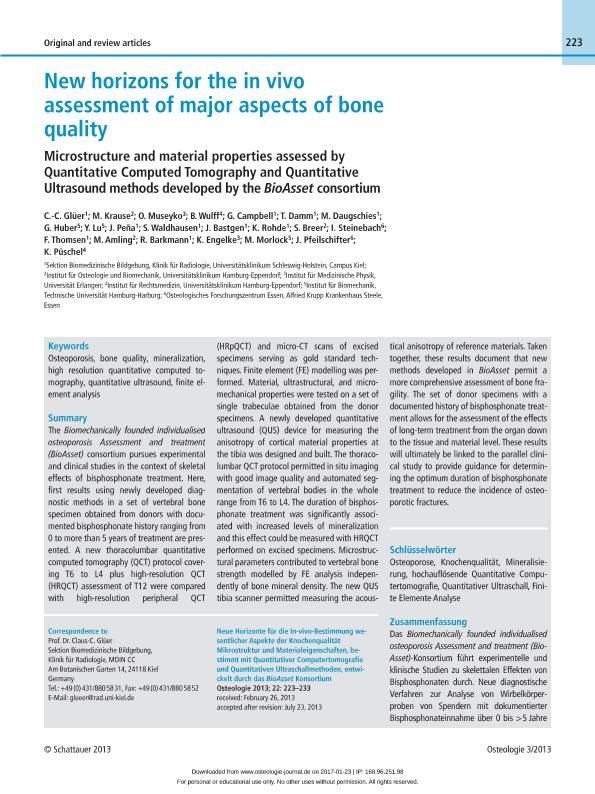Artículo
The Biomechanically founded individualised osteoporosis Assessment and treatment (BioAsset) consortium pursues experimental and clinical studies in the context of skeletal effects of bisphosphonate treatment. Here, first results using newly developed diagnostic methods in a set of vertebral bone specimen obtained from donors with documented bisphosphonate history ranging from 0 to more than 5 years of treatment are presented. A new thoracolumbar quantitative computed tomography (QCT) protocol covering T6 to L4 plus high-resolution QCT (HRQCT) assessment of T12 were compared with high-resolution peripheral QCT (HRpQCT) and micro-CT scans of excised specimens serving as gold standard techniques. Finite element (FE) modelling was performed. Material, ultrastructural, and micromechanical properties were tested on a set of single trabeculae obtained from the donor specimens. A newly developed quantitative ultrasound (QUS) device for measuring the anisotropy of cortical material properties was designed and built. The thoracolumbar QCT protocol permitted in situ imaging with good image quality and automated segmentation of vertebral bodies in the whole range from T6 to L4. The duration of bisphosphonate treatment was significantly associated with increased levels of mineralization and this effect could be measured with HRQCT performed on excised specimens. Microstructural parameters contributed to vertebral bone strength modelled by FE analysis independently of bone mineral density. The new QUS scanner permitted measuring the acoustical anisotropy of reference materials. Taken together, these results document that new methods developed in BioAsset permit a more comprehensive assessment of bone fragility. The set of donor specimens with a documented history of bisphosphonate treatment allows for the assessment of the effects of long-term treatment from the organ down to the tissue and material level. These results will ultimately be linked to the parallel clinical study to provide guidance for determining the optimum duration of bisphosphonate treatment to reduce the incidence of osteoporotic fractures. Das Biomechanically founded individualised osteoporosis Assessment and treatment (BioAsset) Konsortium führt experimentelle und klinische Studien zu skelettalen Effekten von Bisphosphonaten durch. Neue diagnostische Verfahren zur Analyse von Wirbelkörperproben von Spendern mit dokumentierter Bisphosphonateinnahme über 0 bis >5 Jahre wurden entwickelt. Mittels thorakolumbaler Quantitativer Computertomographie (QCT) und hochauflösender QCT (HRQCT) wurden Knochenmineraldichte (BMD), Mikrostrukturvariablen und Materialeigenschaften, insbesondere Mineralisierung, untersucht. Finite Element (FE) Modellierung dient der Bestimmung der Wirbelkörperbruchlast. Ein neues Quantitatives Ultraschall (QUS) Gerät zur Messung anisotroper kortikaler Materialeigenschaften wurde konstruiert. Ein signifikanter Zusammenhang von Mineralisierung und (Dauer der) Bisphosphonattherapie konnte mit Mikro-CT und HRQCT nachgewiesen werden. Das thorakolumbale QCT Protokoll ermöglichte eine Dosisreduktion von 60% gegenüber Standardprotokollen. Eine Finite Elemente Analyse zeigte BMD und Trabekelanzahl als unabhängige Determinanten der Bruchlast. Mit dem neuen QUS Gerät konnte die akustische Anisotropie von Referenzmaterialien bestimmt werden. Die Daten dokumentieren erweitere Diagnosemöglichkeiten zur Abschätzung von Knochenfragilität durch die neuen Verfahren. Parallel durchgeführte klinische Studien sollen die Frage der optimalen Dauer von Bisphosphonattherapie klären.
New horizons for the in vivo assessment of major aspects of bone quality: microstructure and material properties assessed by Quantitative Computed Tomography and Quantitative Ultrasound methods developed by the BioAsset consortium
Título:
Neue Horizonte für die in vivo Bestimmung wesentlicher Aspekte der Knochenqualität: Mikrostruktur und Materialeigenschaften, bestimmt mit Quantitativer Computertomographie und Quantitativen Ultrasound Methoden, entwickelt durch das BioAsset Konsortium
Glüer, Claus C.; Krausse, Matthias; Museyko, Oleg; Wulff, Birgit; Campbell, Graeme; Damm, Timo; Daugschies, Melanie; Huber, Gerd; Lu, Yongtao; Peña, Jaime; Waldhausen, Sonja; Bastgen, Jan; Rodhe, Kerstin; Steinebach, Inga; Thomsen, Felix Sebastian Leo ; Amling, Michael; Barkmann, Reinhard; Engelke, Klaus; Morlock, Michael M.; Pfeilschifter, Johannes; Püschel, Klaus
; Amling, Michael; Barkmann, Reinhard; Engelke, Klaus; Morlock, Michael M.; Pfeilschifter, Johannes; Püschel, Klaus
 ; Amling, Michael; Barkmann, Reinhard; Engelke, Klaus; Morlock, Michael M.; Pfeilschifter, Johannes; Püschel, Klaus
; Amling, Michael; Barkmann, Reinhard; Engelke, Klaus; Morlock, Michael M.; Pfeilschifter, Johannes; Püschel, Klaus
Fecha de publicación:
07/2013
Editorial:
Schattauer Gmbh-verlag Medizin Naturwissenschaften
Revista:
Osteologie
ISSN:
1019-1291
Idioma:
Inglés
Tipo de recurso:
Artículo publicado
Clasificación temática:
Resumen
Archivos asociados
Licencia
Identificadores
Colecciones
Articulos(CCT - BAHIA BLANCA)
Articulos de CTRO.CIENTIFICO TECNOL.CONICET - BAHIA BLANCA
Articulos de CTRO.CIENTIFICO TECNOL.CONICET - BAHIA BLANCA
Citación
Glüer, Claus C.; Krausse, Matthias; Museyko, Oleg; Wulff, Birgit; Campbell, Graeme; et al.; New horizons for the in vivo assessment of major aspects of bone quality: microstructure and material properties assessed by Quantitative Computed Tomography and Quantitative Ultrasound methods developed by the BioAsset consortium; Schattauer Gmbh-verlag Medizin Naturwissenschaften; Osteologie; 22; 3; 7-2013; 169-248
Compartir



